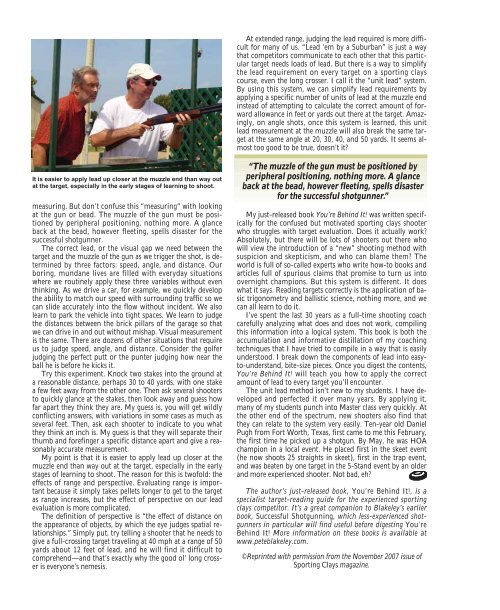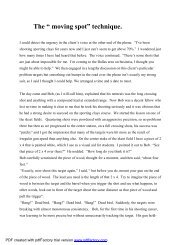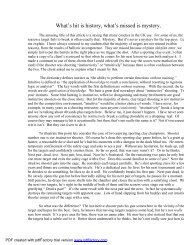ingredient
New Toy's Handling Dynamics And The Old Fence - Pete Blakeley
New Toy's Handling Dynamics And The Old Fence - Pete Blakeley
You also want an ePaper? Increase the reach of your titles
YUMPU automatically turns print PDFs into web optimized ePapers that Google loves.
At extended range, judging the lead required is more difficultfor many of us. “Lead ’em by a Suburban” is just a waythat competitors communicate to each other that this particulartarget needs loads of lead. But there is a way to simplifythe lead requirement on every target on a sporting clayscourse, even the long crosser. I call it the “unit lead” system.By using this system, we can simplify lead requirements byapplying a specific number of units of lead at the muzzle endinstead of attempting to calculate the correct amount of forwardallowance in feet or yards out there at the target. Amazingly,on angle shots, once this system is learned, this unitlead measurement at the muzzle will also break the same targetat the same angle at 20, 30, 40, and 50 yards. It seems almosttoo good to be true, doesn’t it?It is easier to apply lead up closer at the muzzle end than way outat the target, especially in the early stages of learning to shoot.measuring. But don’t confuse this “measuring” with lookingat the gun or bead. The muzzle of the gun must be positionedby peripheral positioning, nothing more. A glanceback at the bead, however fleeting, spells disaster for thesuccessful shotgunner.The correct lead, or the visual gap we need between thetarget and the muzzle of the gun as we trigger the shot, is determinedby three factors: speed, angle, and distance. Ourboring, mundane lives are filled with everyday situationswhere we routinely apply these three variables without eventhinking. As we drive a car, for example, we quickly developthe ability to match our speed with surrounding traffic so wecan slide accurately into the flow without incident. We alsolearn to park the vehicle into tight spaces. We learn to judgethe distances between the brick pillars of the garage so thatwe can drive in and out without mishap. Visual measurementis the same. There are dozens of other situations that requireus to judge speed, angle, and distance. Consider the golferjudging the perfect putt or the punter judging how near theball he is before he kicks it.Try this experiment. Knock two stakes into the ground ata reasonable distance, perhaps 30 to 40 yards, with one stakea few feet away from the other one. Then ask several shootersto quickly glance at the stakes, then look away and guess howfar apart they think they are. My guess is, you will get wildlyconflicting answers, with variations in some cases as much asseveral feet. Then, ask each shooter to indicate to you whatthey think an inch is. My guess is that they will separate theirthumb and forefinger a specific distance apart and give a reasonablyaccurate measurement.My point is that it is easier to apply lead up closer at themuzzle end than way out at the target, especially in the earlystages of learning to shoot. The reason for this is twofold: theeffects of range and perspective. Evaluating range is importantbecause it simply takes pellets longer to get to the targetas range increases, but the effect of perspective on our leadevaluation is more complicated.The definition of perspective is “the effect of distance onthe appearance of objects, by which the eye judges spatial relationships.”Simply put, try telling a shooter that he needs togive a full-crossing target traveling at 40 mph at a range of 50yards about 12 feet of lead, and he will find it difficult tocomprehend—and that’s exactly why the good ol’ long crosseris everyone’s nemesis.“The muzzle of the gun must be positioned byperipheral positioning, nothing more. A glanceback at the bead, however fleeting, spells disasterfor the successful shotgunner.”My just-released book You’re Behind It! was written specificallyfor the confused but motivated sporting clays shooterwho struggles with target evaluation. Does it actually work?Absolutely, but there will be lots of shooters out there whowill view the introduction of a “new” shooting method withsuspicion and skepticism, and who can blame them? Theworld is full of so-called experts who write how-to books andarticles full of spurious claims that promise to turn us intoovernight champions. But this system is different. It doeswhat it says. Reading targets correctly is the application of basictrigonometry and ballistic science, nothing more, and wecan all learn to do it.I’ve spent the last 30 years as a full-time shooting coachcarefully analyzing what does and does not work, compilingthis information into a logical system. This book is both theaccumulation and informative distillation of my coachingtechniques that I have tried to compile in a way that is easilyunderstood. I break down the components of lead into easyto-understand,bite-size pieces. Once you digest the contents,You’re Behind It! will teach you how to apply the correctamount of lead to every target you’ll encounter.The unit lead method isn’t new to my students. I have developedand perfected it over many years. By applying it,many of my students punch into Master class very quickly. Atthe other end of the spectrum, new shooters also find thatthey can relate to the system very easily. Ten-year old DanielPugh from Fort Worth, Texas, first came to me this February,the first time he picked up a shotgun. By May, he was HOAchampion in a local event. He placed first in the skeet event(he now shoots 25 straights in skeet), first in the trap event,and was beaten by one target in the 5-Stand event by an olderand more experienced shooter. Not bad, eh?The author’s just-released book, You’re Behind It!, is aspecialist target-reading guide for the experienced sportingclays competitor. It’s a great companion to Blakeley’s earlierbook, Successful Shotgunning, which less-experienced shotgunnersin particular will find useful before digesting You’reBehind It! More information on these books is available atwww.peteblakeley.com.©Reprinted with permission from the November 2007 issue ofSporting Clays magazine.





